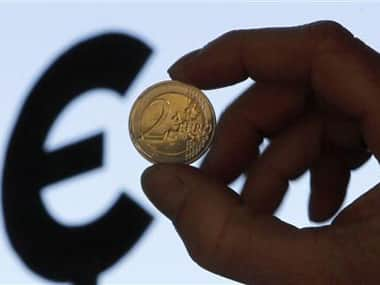Reports about the impending death of the euro may be vastly exaggerated. But the chances are by this time next year, the euro’s goose will be well and truly cooked.
For the last two-and-a-half years, every passing month has only deepened the crisis. The eurozone is now only a whisker away from
serious recession.
[caption id=“attachment_389576” align=“alignleft” width=“380”]
 Survival threat. [/caption]
Survival threat. [/caption]
First, it was Greece. Then Ireland. Then Portugal. All needed hefty bailouts and are still not out of the woods. Next, it could be Spain . This is what the markets appeared to be acknowledging when they pushed Spain’s 10-year bond yields over 7.5 percent on Monday - when Germany pays just 1.15 percent.
The problem with the eurozone’s crisis-where one after another heavily indebted countries are being forced to seek bailouts-is that it is somewhat like that proverbial frog which is sitting in hot water that is getting hotter, but very, very slowly. At some point the heat gets too much, and the frog dies. Why didn’t it jump out? It did not realise that the heat is rising, since the rate of rise was too little for it to note the change and save itself.
The moral of the story is that a sudden heat shock would have helped it survive, instead of an increase in small doses.
Consider this. The Greek part of the eurozone crisis first surfaced in December 2009 - a little more than a year after the Lehman crisis, when the Europeans were smirking about those irresponsible American bankers. It was discovered that Greece had lied about its debts, which were seen at 113 percent of GDP - twice the permissible limit (See the full timeline here ).
But it took the eurozone’s leaders six months to work out the first real bailout package (after two false starts) of 110 billion in May 2010.
Impact Shorts
More ShortsBy then the markets had begun sniffing further crisis elsewhere.
In short order, Ireland was bailed out in November 2010 ( 85 billion), followed by Portugal in May 2011 (78 billion), and there was a second bailout for Greece (109 billion) in July 2011.
Spain then started showing signs of bank failures - but it took the eurozone nearly a year to acknowledge that and proffer a 100 billion bank bailout package.
But with the Spanish economy contracting for three consecutive quarters, once again this is too little, too late. The markets now expect Spain to seek a formal bailout, followed by Italy.
But it is not only countries that have been given a lifeline. The entire banking system has been given nearly a trillion euros of easy money to break the liquidity crisis. The first Long-Term Repo Operation gave European banks (over 800 of them) 530 billion and 489 billion in two tranches, in December 2011 and February 2012, on terms that would have shamed sugar daddies.
Banks got funds for three years at 1 percent interest. Most of them tanked up on cheap money to retire any costlier funds they may have had.
Thus, if anybody gets the impression that the eurozone’s leaders are doing nothing, that impression is completely wrong.
However, if anybody gets the impression that any of this medicine will work, they too are probably wrong.
The tragedy of the euro crisis-where countries rashly entered into a currency union without the discipline of a common central bank or a tight fiscal policy-is that it is all being enacted in broad daylight, where everyone can see that the emperor has no clothes.
The European Central Bank, unlike the US Fed or our own Reserve Bank of India, is not a banker of last resort. It does not have a licence to print money. This is why even though the US and UK are in the same hot water, they are less likely to implode. Instead, they are busy printing currency to boost the economy. They will pay a different price-through inflation or debauched money-but they won’t default like Greece.
In Europe, every time the leaders try to move forward towards a solution (which is usually a bit more money, a bigger bailout), the markets try to guess whether this will work, and usually come to the conclusion that it won’t. Punters then push the next nation towards crisis by sending the cost of debt higher for that country. This is why Spanish bonds are being financed at more than six times the cost of the same bonds for Germany.
When will Europe’s agony end?
Only if all countries agree to surrender significant political and economic sovereignty in favour of Germany - the only big and solvent nation in Europe.
The eurozone’s failure is largely due to this fundamental flaw in its design where too many irresponsible sovereigns assumed that the euro was a free ride to prosperity.
Currently, there is no single political authority that can decide for Europe - and thus every country uses its sovereign right to overspend and bring on a budgetary crisis that can only be corrected by prolonged austerity.
But prolonged austerity leads to economic contraction and reduce a country’s ability to service the debts.
The only answer is to write off more debts - and for the whole of Europe to pay for it by a reduction in wealth and well-being over the medium term.
No one is betting that Europe has this kind of capacity for pain. The chances are it will implode, and at least some of the countries will have to opt out of the euro.
Anyone writing about the eurozone crisis in 2014 will probably note that it was actually a tragedy unfolding in slow motion.
)